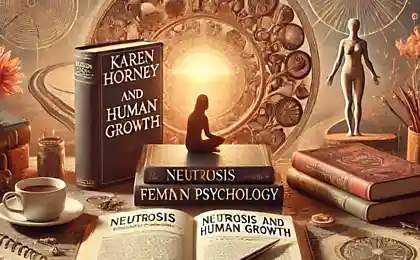250
Frederick Perls: The Birth of a Neurosis

Introduction. One of the most important figures in the history of psychology and psychotherapy of the XX century was Frederick (Fritz) Perls. His name is inseparable from Gestalt therapy - a unique direction, which is based on the view of man as a whole being with an inextricable connection between the body, emotions and mind. Perls believed that the way to inner harmony lies through awareness of their feelings and needs, as well as the ability to interact with the surrounding reality without old patterns. However, in the opinion of Frederick Perls, we often encounter an obstacle that interferes with such harmony – neurosis. It arises, according to the logic of Gestalt therapy, when a person ceases to adapt to a changing environment and stubbornly clings to the usual, but already ineffective ways of acting. As a result, the inner energy gets stuck, the emotional blocks are strengthened, and the personality begins to experience a constant feeling of discomfort. In this article, we will examine how Perls himself described the birth of neurosis and why understanding this concept remains important to modern psychology.
A brief biography and context of Gestalt therapy
Frederick Perls was born in the early twentieth century (1893-1970) and originally educated in medicine, which allowed him to combine both biological and psychoanalytic aspects in his view of the human psyche. Gradually fascinated by philosophy, art and psychoanalysis, he created his own concept, absorbing the best ideas of different schools. Perls was especially influenced by the works of Sigmund Freud and Carl Gustav Jung, as well as the views of existential psychology.
The word “gestalt” itself, borrowed from Gestalt psychology, reflects the principle that a person cannot be understood only through the prism of individual sensations or thoughts. We are a living, ever-changing whole, and any attempt to separate a person into “partitions” is meaningless. Based on this, Gestalt Therapy, created by Perls and his colleagues, focuses on helping a person become whole rather than "fixed piecemeal."

When Neurosis is Born: Perls' Key Ideas
According to Frederick Perls, neurosis begins when the individual is unwilling or unable to change his mode of action in response to changes in his environment or his own needs. The defense mechanisms that once helped manage stress or trauma turn into “frozen” habits, making it difficult to adapt to current realities. As a result:
- Contact is interrupted. Instead of organically reacting to a new situation, a person tries to stay in the old, familiar, albeit uncomfortable state. This interrupts the natural flow of experience.
- Unconscious conflicts accumulate. Repressed feelings (resentment, fear, anger) and unrealized desires continue to manifest, but the individual blocks their awareness for fear of losing illusory control.
- An incomplete gestalt is formed. This is what Perls called the incomplete situations or emotional cycles that return a person to a “stuck” experience over and over again. These are experiences that have not found resolution or expression.
Such a neurotic structure, according to Perls, deprives a person of the opportunity to fully live “here and now”. He tends to either constantly “hang” in the past, reflecting on traumatic events, or run away into the future, fantasizing about what it should look like, but not taking concrete steps to change reality. It blocks spontaneity, creativity, and genuine contact with oneself and others.
Stages of Neurosis in the Gestalt Approach
Frederick Perls identified several stages through which a person passes in the process of forming a neurotic state. Although these stages may differ from author to author, Perls’ classic description often presents them as:
- The phase of false rest (unconsciousness). A person does not notice problems, ignores the signals of discomfort and acts out of habit.
- Anxiety phase. There is an internal conflict, the first signs of anxiety and doubt. A person begins to realize that their way of acting stops working, but “automatically” tries to maintain the status quo.
- Chaos phase. The old patterns are no longer helpful and the new ones are not. This is a painful but important moment when an individual is faced with a choice: continue to “deny” reality or seek new ways to respond.
- Change phase. A person ceases to struggle with what he cannot change, and accepts the very fact of the need for change. This provides an opportunity for more flexible behaviour.
- The Revival Phase (New Gestalt) At this stage comes clarity, there is an integration of feelings, thoughts and actions. The individual acquires the resource to create new life scenarios.
It is important to note that these phases are not a rigid scheme, but rather a metaphor for the dynamics of internal processes. In practice, some stages can occur in parallel or repeat.
The role of awareness in overcoming neurosis
For Frederick Perls, development was the central way out of neurosis. consciousness (awareness). He emphasized that mindfulness is not mental understanding, but rather the ability to “be inside” one’s own feelings and bodily sensations without fleeing into the past or the future. It is through living in the present moment that the individual learns:
- Recognize real needs. Understand what is really important to me now: food, rest, conversation or solving some professional task.
- Identify destructive habits. For example, the habit of silencing feelings, being afraid to say no, or endlessly blaming yourself for the slightest mistakes.
- Experiment with new behaviors. Instead of avoiding a difficult conversation, you can start it, even in a shortened format. Instead of the usual self-digging, write down feelings in a diary. Each experiment reveals an additional resource.
- Express repressed emotions. Restrained anger or resentment can find healthier forms of exit through conversation, creativity, or physical activity.
Research published in the Journal of the American Psychological Association confirms that mindfulness practices and cognitive behavioral techniques, including those integrated into the Gestalt approach, effectively help reduce symptoms of anxiety and depression.

The Practical Value of Perls's Ideas Today
Why is Frederick Perls’s view of the birth of neurosis and how to overcome it still relevant? First of all, because he prioritized flexibility and the ability to adapt creatively, which is becoming more important every day in today’s fast-changing world. People often face unexpected changes in work, relationships, or even in the global political environment, and if we lack the ability to respond flexibly, there is a high risk of getting stuck in neurosis.
In addition, Perls emphasized that most human problems lie in the sphere of relationships: with oneself, with relatives, with colleagues, with society as a whole. This is where many long-standing conflicts and unexplained feelings are rooted. Therefore, Gestalt therapy, while remaining true to the original ideas of its founder, offers specific techniques and exercises aimed at:
- Translate abstract experiences into concrete bodily sensations and feelings.
- Learn to articulate your needs clearly without hiding them behind masks or accusations.
- Complete “open gestalts” through conversations, creative acts, or symbolic actions (e.g., writing a resentment that can then be broken).
- Increase self-esteem by realizing personal responsibility for the quality of one’s life.
According to some scientific studies, therapeutic methods based on Gestalt principles improve the psychological stability of people, help to form a deeper understanding of their desires and find a healthy way out of conflict situations.
Conclusion: the relevance of the ideas of Frederick Perls
Frederick Perls has left a prominent mark on psychology thanks to his pioneering ideas about the nature of neurosis and the path to the integrity of the individual. Based on the principles of self-regulation and creative adaptation, Perls proved that neurosis is not a life sentence. It occurs when a person is stuck in old patterns, unable or unwilling to adapt to a new reality, but this state can be overcome through awareness, addressing their own experiences, and learning healthy ways to interact with the world.
Today, as the pace of life accelerates and demands for mental well-being grow higher, the concepts pioneered by Friedrich Perls continue to inspire psychologists and psychotherapists around the world. They maintain their relevance by helping people practice flexible behaviors and learn to build a true connection to the environment. Ultimately, the path to overcoming neurosis is the path to greater freedom and depth of being that anyone can take if they dare to face their fears and unfinished stories. Acceptance, awareness, and courage to change are three of the most important tools that Perls has left to anyone seeking psychological growth.























